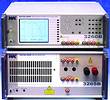Transformer tester with telecom functions
23 May 2001
Test & Measurement

The explosive growth of PCs connected to the telephone system for Internet access has resulted in a need to measure insertion loss (IL) and return loss (RL) of line matching transformers. British-based company Wayne Kerr has introduced the 3260B Precision Magnetics Analyser for just this purpose.
Distributed in South Africa by Protea Electronics' Communications & Measurement Division, the 3260B delivers top-of-the-range performance and functionality.
The user can select values for terminating resistance or impedance and configure a damped network or series blocking capacitor, if required. Complete component characterisation is also available using the analysis mode. The 3260B can graph any of the measured parameters such as inductance or impedance, including secondary term, against frequency, AC drive level or DC bias current. Up to 124 A of DC bias current can be applied. The graphed response can be displayed linearly or logarithmically.
Key features include: wide frequency range - 20Hz to 3MHz; basic accuracy - 0,1%; telecom measurement function; analysis mode (graphing); swept-frequency, AC drive level and DC bias current; comprehensive measurement functions, including leakage tests; intuitive operation; IEEE488 control using free LabVIEW driver.
The Wayne Kerr range provides a full complement of measurements, which can test a wide range of inductors and transformers. The new products 3255B, 3260B and 3265B, provide industry-leading accuracy, fast measurement speed and a full range of measurement functions.
Protea Electronics' Communications & Measurement Division
(011) 786 3647
Further reading:
hybridNETBOX instrumentation platform
Vepac Electronics
Test & Measurement
The hybridNETBOX from Spectrum Instrumentation is an innovative instrumentation platform that combines a multi-channel arbitrary waveform generator (AWG) and a digitiser in a single portable unit.
Read more...
14-bit AWG at 20 GS/s
Vepac Electronics
Test & Measurement
The Arb Rider AWG-7000 is the world’s fastest 14-bit Arbitrary Waveform Generator, featuring a 20 GS/s real time update rate and 14-bit vertical resolution.
Read more...
Additions to APD5000 series oscilloscopes
Osiris Technical Systems
Test & Measurement
Each unit is equipped with an integrated CAT II digital multimeter, three programmable power supplies, a dedicated trigger line, and an arbitrary waveform generator.
Read more...
Handheld RTSA up to 9,5 GHz
Vepac Electronics
Test & Measurement
The PXE-90 implements an FFT engine on the built-in FPGA and support frame compression with trace detection while ensuring no missing samples between FFT frames.
Read more...
InterCal introduces a new range of calibrators
Intercal
Test & Measurement
Calibration is a critical process in numerous industries, from manufacturing to healthcare, ensuring that instruments and devices provide accurate and reliable measurements.
Read more...
Power Energy Meter for solar projects
Mimic Components
Test & Measurement
The Mi550 Power Energy Meter is a handheld three-phase power quality analyser that connects externally with Rogowski coils or voltage-type CTs, allowing for testing without disconnection.
Read more...
MT8870A for NTN NB-IoT testing
Tamashi Technology Investments
Test & Measurement
Samsung Electronics has selected the Anritsu Universal Wireless Test Set MT8870A for use on the mass-production lines of the Galaxy S25.
Read more...
XJLink-PF40 JTAG controller
ASIC Design Services
Test & Measurement
XJTAG, a specialist in electronic testing, has released its new XJLink-PF40 JTAG controller together with version 4 of its popular PCB software testing suite.
Read more...
INTEGRA Biosciences’ reagent dispenser now supports SiLA-2 integration
Test & Measurement
This new functionality will make it even easier to integrate the WELLJET into automated laboratory workflows, helping labs to enhance their productivity and reproducibility.
Read more...
Advanced portable spectrum analyser
Vepac Electronics
Test & Measurement
HAROGIC has introduced the SAE-200, a USB-based real-time spectrum analyser that operates from 9 to 20 GHz with a 100 MHz bandwidth.
Read more...

